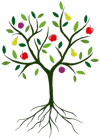Bloody Ploughman
Malus domestica There are numerous stories about the origins of this well-known Scottish apple. In essence the variety arose as a seedling, allegedly near the grave of a ploughman who had been shot by a gamekeeper for stealing apples (or perhaps something more valuable). The knobbly skin is indeed a crimson-red colour, and this is also a variety where the flesh can sometimes be stained red as well.
Bloody Ploughman is often considered an eating apple in Scotland, but south of the border tends to be regarded as a cooker!
Bloody Ploughman apple trees for sale
1-year bare-root
tree
on MM106 rootstock£34.95
Mature height: 3m-5m after 10 years
Can be trained on as a large free-standing apple tree, a half-standard apple tree, a large apple fan or espalier, or a pleached apple tree. Available next season
Recommended pollinators for Bloody Ploughman apple trees
Bloody Ploughman is not self-fertile, so you will need another different but compatible variety planted nearby in order to produce fruit.
The following varieties are good pollinators for Bloody Ploughman.
If you are not sure about pollination requirements don't hesitate to ask us.
Ellison's OrangeEllison's Orange is a well respected Cox-style apple which can achieve very good flavour.
BraeburnBraeburn is one of the best-flavoured supermarket apple varieties.
GalaGala is popular supermarket apple - but better when home-grown, with a sweet pleasant flavour.
Newton WonderA traditional English cooking apple, a good alternative to Bramley.
King of the PippinsA popular and versatile dual-purpose apple, widely grown in the Victorian era.
John DownieJohn Downie is a traditional crab apple for making crab apple jelly. White blossom and orange-red fruits.
Peasgood's NonsuchPeasgood Nonsuch is a highly-regarded old-fashioned English cooking apple.
Golden HornetMalus Golden Hornet is a traditional white blossom crab apple, with persistent yellow fruits.
History
Bloody Ploughman originates from the area around Megginch in the Carse of Gowrie in eastern Scotland. It was first recorded in 1883, and it is rumoured that the original tree is still alive.
The Carse of Gowrie is an area of high quality agricultural land between the towns of Perth and Dundee. It has long been associated with fruit-growing, and has one of the best climates in Scotland, with a combination of low rainfall and good levels of sunshine. Whilst the ancestry of Bloody Ploughman is unknown, the story suggests it is most likely a seedling of a local variety.
Bloody Ploughman characteristics
- Gardening skillAverage
- Self-fertile?Not self-fertile
- Pollinating othersAverage
- Pick seasonMid
- Picking periodmid-September
- Keeping1-2 months
- Food usesCulinaryJuiceHard cider
- Country of originUnited Kingdom - Carse of Gowrie, Scotland
- Period of origin1850 - 1899
- Fruit colourRed / Green
You might also like these varieties
Coul BlushCoul Blush is an early-season dual-purpose apple from Scotland.
Galloway PippinA traditional Scottish cooking apple which keeps its shape when cooked.
Scotch DumplingScotch Dumpling is a large Scottish cooking apple. Cooks to a frothy puree with a good flavour.
Stirling CastleA traditional Scottish cooker from the Victorian era, with a good sharp flavour.
More about apple trees
We've all grown up with Bramley cookng apples so we take it for granted that cooking apples are different to eating apples, but, surprisingly, the UK is one of the few countries that makes such a distinction between apples for cooking and apples for eating fresh.
The main qualtities of a good "cooker" are size - the bigger the better - and acidity. Counter-intuitively, it is the acid which gives cooking apples their flavour. In contrast the flavour of sweet dessert apples collapses with cooking.
Cooking apples are usually easier to grow than eating apples, and will tolerate partial shade.
